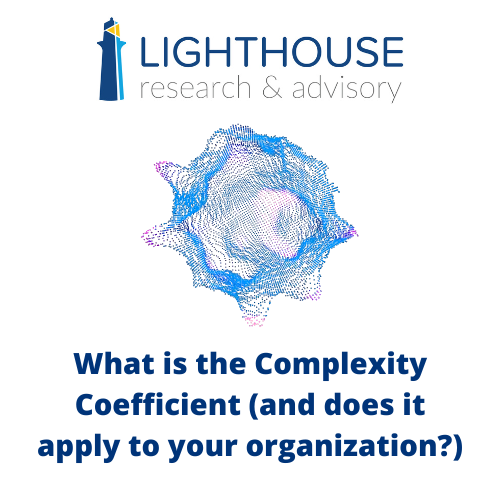What is the Complexity Coefficient and Does it Apply to Your Organization?
In our research on high-performing organizations, the term “complexity coefficient” is one that we use to describe companies that are outliers from the standpoint of investment into HR operations.
What exactly is this coefficient, and why is it a crucial factor in organizational management? In essence, the complexity coefficient describes a phenomenon where an organization’s HR needs and technology requirements are influenced by various complexity factors, such as industry or vertical, executive leadership’s view of HR, and other unique organizational characteristics.
This is contrary to the typical norms where employers add HR complexity, technology, staff, and resources at specific milestones as they grow and expand. For instance, in our previous research on HR technology adoption in SMB organizations, we found that companies typically adopted technology along a curve as they changed HR leadership, added new states/locations, or hit employee headcount thresholds.  But the complexity coefficient is something else.
But the complexity coefficient is something else.
Consider this: a 50-person biotechnology firm might have the HR intricacies of a much larger company, say a 500- or 5,000-person firm. Why? One factor is because they compete aggressively for a niche talent – research scientists. This is a perfect illustration of the complexity coefficient in action. It’s not just about the size of the company; it’s about the nature and demands of its operations and workforce. And this isn’t an example pulled from thin air–it is directly drawn from one of our research interviews during this year’s Compensation Trends and Technology Landscape study.
Some Drivers of the Complexity Coefficient
What drives a company to be significantly impacted by the complexity coefficient? Here are some common elements:
- Industry Requirements: High-tech, healthcare, and biotech industries often require specialized talents, driving up HR complexity.
- Leadership Perspective: A CEO valuing HR and people investment can lead to enhanced focus and resources on HR functionalities.
- Regulatory Environment: Companies in heavily regulated industries face additional HR challenges in compliance and reporting.
Any one of these might be enough to reach the tipping point for the complexity coefficient, but if multiple factors are present, then that dramatically increases the likelihood that a company will be in that category.
Another relevant example: the CHRO for a small technology firm in Boston told us that their HR staff to employee ratio was about 1:25 instead of the more common 1:100 at larger organizations or those that are more transactional in nature.
The Complexity Coefficient: Aligning People Investment
So, what financial implications does adhering to the complexity coefficient principle have for an employer? The answer is not straightforward, but it’s evident that companies recognizing and acting upon these complexity factors tend to invest more in their HR teams and technologies. This investment isn’t just monetary; it’s also about dedicating time and resources to develop sophisticated HR systems that cater to their unique needs.
- Culture and people practices
- HR/talent/learning technology prioritization
- Talent-centric thinking and investment
For instance, a firm deeply entrenched in the complexity coefficient might allocate additional funds – possibly up to 20-30% more – towards its HR budget compared to a similar-sized company in a less complex industry. This investment manifests in advanced HR technologies, comprehensive training programs, competitive compensation packages, and robust talent management strategies.
The complexity coefficient compels organizations to rethink their approach to HR management. By recognizing and adapting to these factors, companies can not only enhance their HR capabilities but also position themselves strategically for long-term success in an ever-evolving business landscape.

Ben Eubanks is the Chief Research Officer at Lighthouse Research & Advisory. He is an author, speaker, and researcher with a passion for telling stories and making complex topics easy to understand.
His latest book Talent Scarcity answers the question every business leader has asked in recent years: “Where are all the people, and how do we get them back to work?” It shares practical and strategic recruiting and retention ideas and case studies for every employer.
His first book, Artificial Intelligence for HR, is the world’s most-cited resource on AI applications for hiring, development, and employee experience.
Ben has more than 10 years of experience both as an HR/recruiting executive as well as a researcher on workplace topics. His work is practical, relevant, and valued by practitioners from F100 firms to SMB organizations across the globe.
He has spoken to tens of thousands of HR professionals across the globe and enjoys sharing about technology, talent practices, and more. His speaking credits include the SHRM Annual Conference, Seminarium International, PeopleMatters Dubai and India, and over 100 other notable events.
